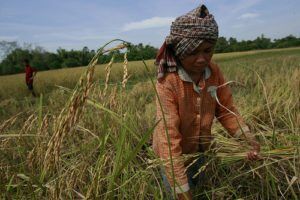

Energy
“Is policy-first the right approach for water?” asks Olam’s Chris Brown
This article first appeared on Thomson Reuters Foundation website and is reproduced with permission. The author is Chris Brown, GM for Environmental Sustainability at Olam, who delivered a keynote speech at UC Davis’ Water Policy for Food Security: A Global Conference in October.
Water permeates every part of life, affects every region of the world, and I can’t think of a single industry that doesn’t rely on water at least in part for its continuing operations. It is telling that while water and sanitation have been announced as a Global Goal in their own right at the recent signing of the Sustainable Development Goals in New York, access to clean, safe water also underpins the vast majority of the other 16 goals to end poverty, foster peace and protect the planet by 2030.
Yet water is a finite resource. How do we balance competing demands, knowing full well that they will only increase as population expands, industry grows and the impacts of climate change become ever more significant?
Policy, it would seem, is the Holy Grail. We await it eagerly, spend days, months and even years discussing the minutiae and delving into the detail. But without being joined up across borders, businesses and water basins, it means very little. The last 20 years of deliberation on water policy have yielded very little real impact on the ground.
Why? Water cannot be ring-fenced. We are all guilty of viewing challenges through our own particular lens, assessing impacts and targets based on our own particular silo. But this simply does not work for water.
Water does not respect the boundaries of our administrative systems or the borders of national governments. There are between 250 and 275 transboundary river basins and at least as many transboundary aquifers globally, yet only six of these aquifers have international legal structures that encourage co-operation. Water cannot be siphoned off into its own department, but rather water planning must be a central plank to every policy decision by every department – be that on housing, environment, business or infrastructure. Perhaps even more importantly, these decisions must be consistently reviewed and maintained if they are to have any chance of success. Decisions on water planning can start with good intentions but become unstuck when they are gradually shunted to the bottom of the priority list as time goes on.
We have seen that even when coherent water policies are decided at the top, they often are not cascaded down consistently to the actors on the ground. If the myriad stakeholders in a water landscape aren’t brought in at the earliest possible stage to have a voice in assessing the practicalities and application of policy, it is unlikely to stick. Initiatives like the International Water Stewardship Programme (IWaSP) and WWF’s Water Stewardship Programme are vital in helping the private sector to collaborate with government departments, other businesses, NGOs and communities across boundaries and borders to protect shared freshwater resources.
Meanwhile, I have seen a growing tide of people turning to the private sector for solutions and, more importantly, for action.
Agriculture accounts for around 70% of global water use, yet very few governments prioritise agriculture over industries that generate greater currency revenues for their coffers. If water becomes scarce, it is often farmers, especially smallholders, who feel it first. There is therefore added impetus for agri-businesses (like Olam) to take action to ensure the long-term viability of our supply chains and food security in regions around the world. Not only must we consider our vulnerabilities today but also plan for future scenarios of increased water scarcity, and any measures that governments might take in response. To mitigate these risks, we need action now both to reduce our own water consumption and ensure that other players within our water landscapes are practising responsible water stewardship – and if we wait for policy-makers to make the first move, it may be too late.
The private sector can be catalysts for basin-level collaboration on water management, even when policy is lagging. For example, when setting up Olam Aviv’s coffee plantation and processing mill in Songea district, Tanzania, we needed access to water for our operations and workers without jeopardising the Ruvuma River ecosystem, or the needs of others. It was in our long-term interest to understand the needs of our neighbours if we wanted to be accepted into the community. Lengthy upstream and downstream water assessments and a daily rainfall-runoff model to measure flows informed workshops with village leaders, the Ministry of Water, development agencies and the operators of a local hydropower plant, who happen to be nuns from the local Benedictine St Agnes Chipole Mission.
As a result of all this work, the Upper Ruvuma Catchment Basin Steering Committee was formed to share knowledge and resources for a more coordinated catchment management strategy into the future, and we have since built a 1.5 million m3 dam to collect rainwater to reduce our dependence on the river during the dry season, planted 50,000 shade trees to reduce evapotranspiration from the coffee plants, and are constructing a wastewater treatment wet-mill. Here we’ve seen real, tangible action driven by business needs and cross-sector collaboration across the water basin. And what’s more, learnings from our experience in Tanzania can be shared with partners across our global operations to find local, scalable and durable solutions.
While policies are being deliberated on a global scale, action needs to start happening in a joined up way on the ground. Water is infinitely challenging to measure, monitor or mediate – its very nature means that collaboration is a perquisite to meaningful action on a landscape level. You need the private sector to take the initiative and catalyse action from the ground up as well.
Ideally policy and action will meet in the middle and ensure that sustainable and equitable water use, including access to fresh water and sanitation is not a luxury but a right for generations to come.


 Environment10 months ago
Environment10 months agoAre Polymer Banknotes: an Eco-Friendly Trend or a Groundswell?

 Environment11 months ago
Environment11 months agoEco-Friendly Home Improvements: Top 7 Upgrades for 2025

 Features9 months ago
Features9 months agoEco-Friendly Cryptocurrencies: Sustainable Investment Choices

 Features10 months ago
Features10 months agoEco-Friendly Crypto Traders Must Find the Right Exchange





























